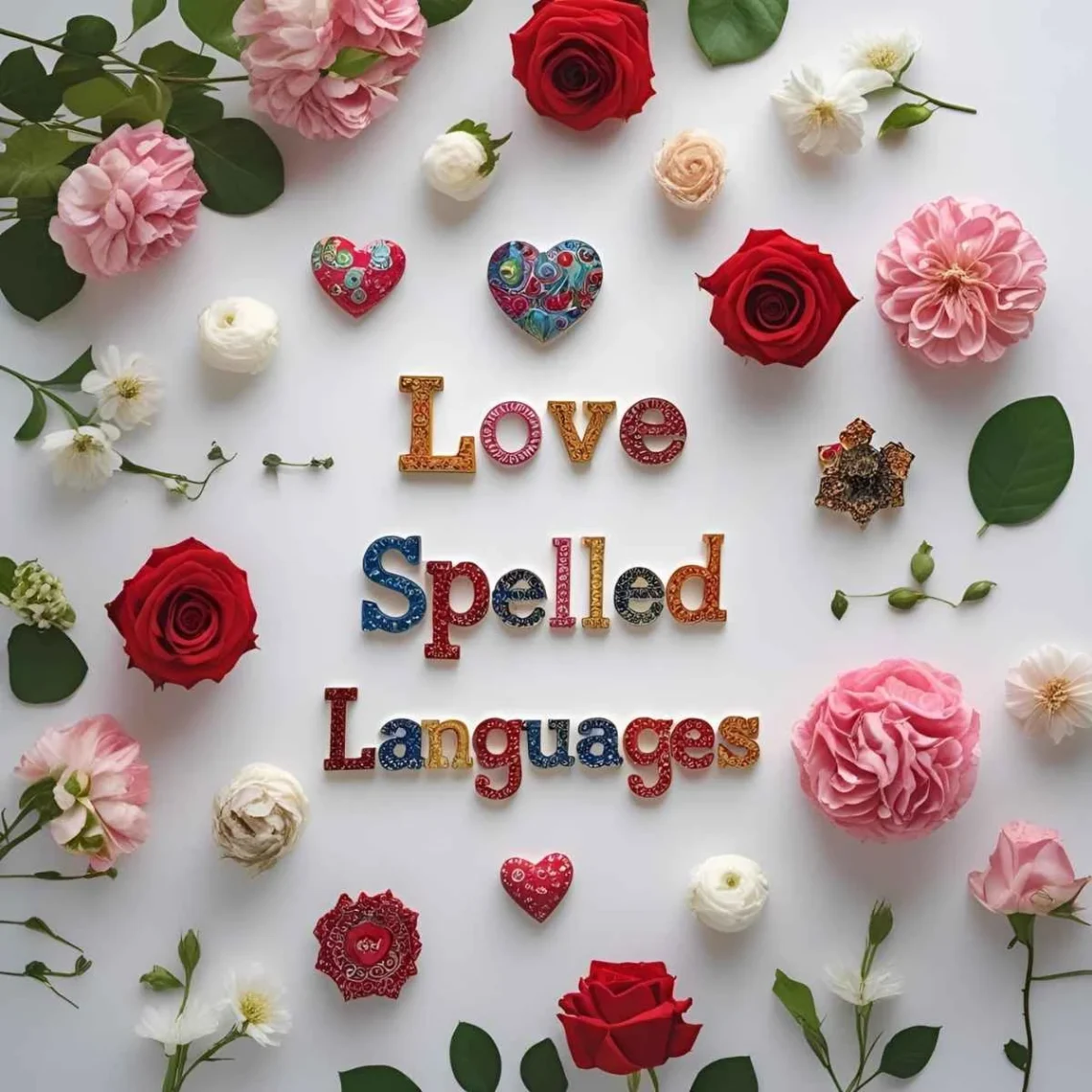Years ago, while traveling through a small Italian village, I saw an elderly couple carving “amore” into a tree, their hands trembling but their smiles radiant. That single word captured a lifetime of devotion, a universal feeling that transcends borders.
Across the world, the word for “love” carries profound meaning, shaped by each culture’s unique perspective. Whether whispered in a Parisian café or sung in a Bollywood ballad, “love” binds humanity together. Let’s journey through languages and cultures to explore how this powerful word is spelled and what it reveals about the heart of each society.
Reference Table: “Love” in Different Languages
| Language | Word for “Love” | Cultural/Linguistic Insight |
|---|---|---|
| French | Amour | Evokes romantic passion, often tied to art and poetry. |
| Spanish | Amor | A versatile term used for romantic, familial, or platonic love. |
| Italian | Amore | Deeply tied to Italy’s tradition of expressive romance. |
| German | Liebe | Conveys both romantic and general affection, rooted in sincerity. |
| Mandarin | Ài (爱) | Emphasizes deep, selfless devotion, often beyond romance. |
| Hindi | Pyaar | Reflects emotional intensity, central to Bollywood’s love stories. |
| Japanese | Ai (愛) | A profound term, often reserved for deep, meaningful bonds. |
| Korean | Sarang (사랑) | Used for romantic and familial love, with a tender tone. |
| Arabic | Hubb (حب) | Rooted in poetic traditions, used across over 20 countries. |
| Swahili | Upendo | A gender-neutral term, emphasizing universal affection. |
| Zulu | Uthando | Conveys deep emotional connection, often communal. |
| Yoruba | Ìfẹ́ | Tied to spiritual and familial bonds, beyond romance. |
| Maori | Aroha | Encompasses love, compassion, and empathy in community. |
| Hawaiian | Aloha | A multifaceted term for love, affection, and greeting. |
| Cherokee | Gvgeyu | A term for deep, cherished affection, often spiritual. |
European Languages: Passion and Poetry
European languages spell “love” with a blend of passion and tradition. For example, in French, “amour” conjures images of candlelit dinners and poetic declarations, deeply tied to France’s romantic culture. Meanwhile, Spanish uses “amor,” a versatile word for romantic, familial, or even platonic affection. In Spain or Latin America, saying “te amo” is a heartfelt vow. Additionally, Italian’s “amore” carries a lyrical quality, reflecting Italy’s history of operatic romance. A couple in Venice might whisper “amore” during a gondola ride. In contrast, German’s “Liebe” is sincere and broad, used for both romantic partners and dear friends, aligning with Germany’s straightforward yet warm culture.
Thus, European terms for “love” range from poetic (French, Italian) to practical (German), each reflecting cultural attitudes toward affection and connection.
Asian Languages: Depth and Diversity
Asia’s diverse languages offer unique spellings for “love,” each with cultural nuance. For instance, in Mandarin, “ài” (爱) signifies selfless devotion, often extending beyond romance to family or country. In China, expressing “wǒ ài nǐ” is a serious commitment. Similarly, Hindi’s “pyaar” evokes the emotional intensity of India’s love stories, from poetry to Bollywood films. In Japanese, “ai” (愛) is reserved for profound bonds, often unspoken due to cultural restraint. A Tokyo couple might show “ai” through actions rather than words. Meanwhile, Korean’s “sarang” (사랑) is tender, used for both romantic and familial love, as seen in K-dramas. Finally, Arabic’s “hubb” (حب), used in over 20 countries like Morocco and Qatar, carries poetic weight, rooted in the region’s literary heritage.
These variations, from restrained Japanese to expressive Hindi, highlight Asia’s rich spectrum of emotional expression.
African Languages: Community and Connection
In African languages, “love” often ties to community and shared bonds. For example, Swahili, spoken across over 20 countries like Kenya and Uganda, uses “upendo,” a gender-neutral term for universal affection. In Zulu, “uthando” conveys deep emotional connection, often celebrated in South African communal gatherings. Similarly, Yoruba’s “ìfẹ́,” used in Nigeria, blends romantic and spiritual love, reflecting the culture’s holistic view of relationships. These terms, spoken in vibrant markets or family ceremonies, emphasize love as a collective experience, uniting people across diverse African societies.
Indigenous & Island Languages: Love as a Way of Life
Indigenous and island languages spell “love” with an emphasis on community and spirit. For instance, Maori in New Zealand uses “aroha,” which encompasses love, compassion, and empathy, often expressed in communal rituals. In Hawaiian, “aloha” is a multifaceted term, meaning love, affection, and greeting, embodying the islands’ welcoming spirit. Similarly, Cherokee’s “gvgeyu” signifies deep, spiritual affection, used in Native American communities to honor cherished bonds. In Samoan, “alofa” reflects love as a communal value, shared through family and cultural practices. Across these cultures, from Pacific islands to the Cherokee Nation, “love” is a way of life, woven into daily interactions.
Cultural Insights: The Timeless Power of Love
The word for “love” has evolved with human history. In ancient Greece, “agape” and “eros” distinguished spiritual and romantic love, influencing modern European terms. In Arabic, “hubb” appears in medieval poetry, shaping its use across the Middle East. Moreover, in African cultures, terms like “upendo” are tied to communal rituals, reflecting love’s role in unity. In Asia, the shift to modern romance has deepened terms like “pyaar,” emphasizing personal choice. These words carry centuries of tradition, from ancient philosophies to modern love songs, showing love’s enduring power across civilizations.
Proverbs and Sayings: Pearls of Wisdom
- French: “Love conquers all.” This reflects the belief in love’s transformative power.
- Hindi: “True love is like a flame that never dies.” It highlights enduring passion.
- Swahili: “Love is a river that flows forever.” This emphasizes love’s continuity.
- Japanese: “Love sees with the heart, not the eyes.” It captures love’s deeper essence.
- Yoruba: “Where there is love, there is peace.” This ties love to harmony.
FAQs
Why do some words for “love” sound similar?
Shared linguistic roots, like Indo-European (French, Spanish) or Arabic’s influence on Swahili, create similarities through historical exchange.
What’s the oldest term for “love”?
Greek’s “agape” and “eros” (circa 8th century BCE) are among the earliest, distinguishing types of affection.
How do cultures shape the term’s use?
Collectivist cultures (e.g., African, Indigenous) view love as communal, while individualistic ones (e.g., European) focus on personal bonds.
Conclusion
From “amour” in France to “upendo” in Tanzania, the word for “love” weaves a global tapestry of human connection. Each term, whether the soulful “pyaar” in Hindi or the communal “aroha” in Maori, reflects unique cultural values while celebrating a shared emotion. Consequently, love’s universal language unites all people, transcending borders and languages. How do you spell and express “love” in your culture? Share your stories below—we’d love to hear how this word resonates with you!





